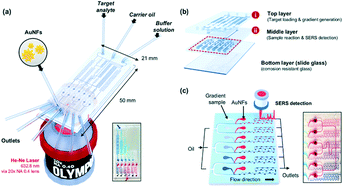SERS-based droplet microfluidics for high-throughput gradient analysis†
Abstract
In the last two decades, microfluidic technology has emerged as a highly efficient tool for the study of various chemical and biological reactions. Recently, we reported that high-throughput detection of various concentrations of a reagent is possible using a continuous gradient microfluidic channel combined with a surface-enhanced Raman scattering (SERS) detection platform. In this continuous flow regime, however, the deposition of nanoparticle aggregates on channel surfaces induces the “memory effect,” affecting both sensitivity and reproducibility. To resolve this problem, a SERS-based gradient droplet system was developed. Herein, the serial dilution of a reagent was achieved in a stepwise manner using microfluidic concentration gradient generators. Then various concentrations of a reagent generated in different channels were simultaneously trapped into the tiny volume of droplets by injecting an oil mixture into the channel. Compared to the single-phase regime, this two-phase liquid/liquid segmented flow regime allows minimization of resident time distributions of reagents through localization of reagents in encapsulated droplets. Consequently, the sample stacking problem could be solved using this system because it greatly reduces the memory effect. We believe that this SERS-based gradient droplet system will be of significant utility in simultaneously monitoring chemical and biological reactions for various concentrations of a reagent.

- This article is part of the themed collection: In celebration of Chinese New Year 2020


 Please wait while we load your content...
Please wait while we load your content...